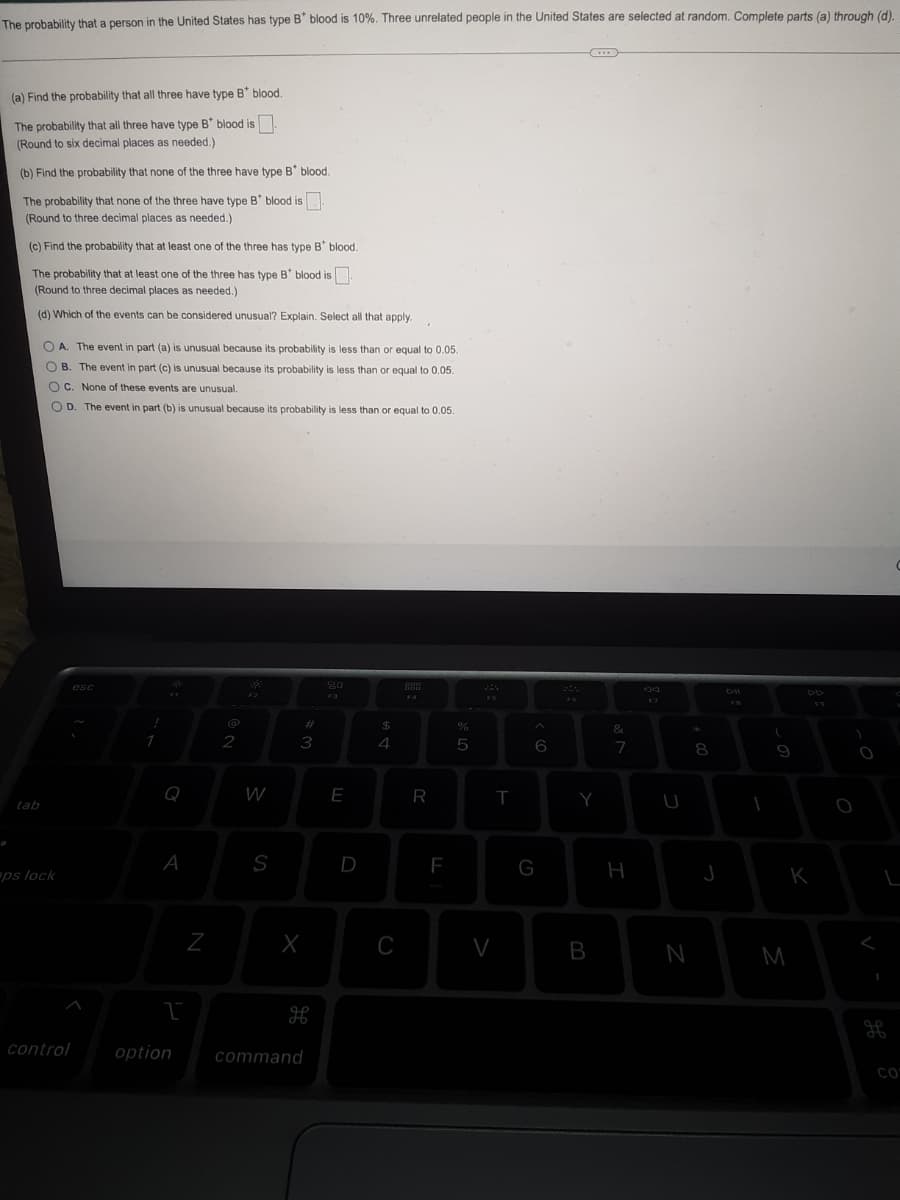The probability that a person in the United States has type B* blood is 10%. Three unrelated people in the United States are selected at random. Complete parts (a) through (d). *** (a) Find the probability that all three have type B* blood. The probability that all three have type B* blood is. (Round to six decimal places as needed.) (b) Find the probability that none of the three have type B* blood. The probability that none of the three have type B* blood is (Round to three decimal places as needed.) (c) Find the probability that at least one of the three has type B blood. The probability that at least one of the three has type B* blood is (Round to three decimal places as needed.) (d) Which of the events can be considered unusual? Explain. Select all that apply. A. The event in part (a) is unusual because its probability is less than or equal to 0.05. B. The event in part (c) is unusual because its probability is less than or equal to 0.05. OC. None of these events are unusual. D. The event in part (b) is unusual because its probability is less than or equal to 0.05. C 0 0 0 0
The probability that a person in the United States has type B* blood is 10%. Three unrelated people in the United States are selected at random. Complete parts (a) through (d). *** (a) Find the probability that all three have type B* blood. The probability that all three have type B* blood is. (Round to six decimal places as needed.) (b) Find the probability that none of the three have type B* blood. The probability that none of the three have type B* blood is (Round to three decimal places as needed.) (c) Find the probability that at least one of the three has type B blood. The probability that at least one of the three has type B* blood is (Round to three decimal places as needed.) (d) Which of the events can be considered unusual? Explain. Select all that apply. A. The event in part (a) is unusual because its probability is less than or equal to 0.05. B. The event in part (c) is unusual because its probability is less than or equal to 0.05. OC. None of these events are unusual. D. The event in part (b) is unusual because its probability is less than or equal to 0.05. C 0 0 0 0
Chapter8: Sequences, Series,and Probability
Section8.7: Probability
Problem 4ECP: Show that the probability of drawing a club at random from a standard deck of 52 playing cards is...
Related questions
Question
100%

Transcribed Image Text:The probability that a person in the United States has type B* blood is 10%. Three unrelated people in the United States are selected at random. Complete parts (a) through (d).
(...)
(a) Find the probability that all three have type B* blood.
The probability that all three have type B* blood is.
(Round to six decimal places as needed.)
(b) Find the probability that none of the three have type B* blood.
The probability that none of the three have type B* blood is
(Round to three decimal places as needed.)
(c) Find the probability that at least one of the three has type B* blood.
The probability that at least one of the three has type B* blood is
(Round to three decimal places as needed.)
(d) Which of the events can be considered unusual? Explain. Select all that apply.
OA. The event in part (a) is unusual because its probability is less than or equal to 0.05.
B. The event in part (c) is unusual because its probability is less than or equal to 0.05.
OC. None of these events are unusual.
OD. The event in part (b) is unusual because its probability is less than or equal to 0.05.
C
-241
d
esc
20
999
F3
tab
aps lock
control
!
1
Q
A
1
option
N
@
2
W
S
3
X
H
command
E
D
$
4
C
R
F
5
T
V
6
G
F6
Y
B
&
7
H
U
N
00*
8
J
DII
1
(
9
K
M
)
O
V
CO
Expert Solution
This question has been solved!
Explore an expertly crafted, step-by-step solution for a thorough understanding of key concepts.
This is a popular solution!
Trending now
This is a popular solution!
Step by step
Solved in 2 steps with 2 images

Recommended textbooks for you

